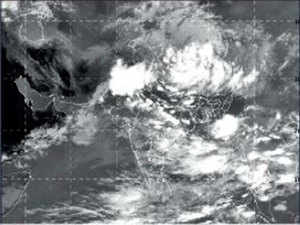
A satellite image from INSAT-3DR taken at 6:45 pm on Saturday.
CHENNAI: Five satellites of the Indian Space Research Organisation are playing a key role in , monitoring the grave flood situation and assisting in relief work.
An Isro official said earth observation satellites Oceansat-2, Resourcesat-2, Cartosat 2 and 2A and INSAT 3DR send real-time images to the ground station which helps in assessing the extent of flooding and planning rescue operations.
"We are using the data from these satellites to provide alerts on flooding, areas of inundation during and after rain, and weather forecasts," the official said. Officials said data is processed at the Decision Support Centre (DSC) at the National Remote Sensing Centre (NRSC) in Hyderabad and disseminated periodically to the Centre and the state under the disaster management support programme of Isro. INSAT-3DR, an advanced meterological satellite configured with an imaging system and an atmospheric sounder, provides data on various parameters like temperature and humidity for weather forecasts.

Other remote sensing satellites like Cartosat and Resourcesat send high resolution images captured by onboard cameras that help send out early flood warnings and map the affected areas. Cartosat 2 and 2A can be steered along and across the track to 45 degrees for frequent imaging of a specific area.
As soon as information on a flood event is received, Isro officials said the earliest available satellite is programmed to collect the required data for demarcating inundated areas. At the DSC, the data is processed and inundation maps are prepared with flooded and non-flooded areas marked in different colours. The maps are disseminated to the state and central agencies concerned, along with providing information on affected villages and transport network, for planning relief operations.
As the satellites help in , instruments deployed in the sea are simultaneously tracking changes in the weather along the west coast. Data from 13 buoys deployed in the Arabian Sea is helping scientists at the Indian National Centre for Ocean Information Services (INCOIS) in Hyderabad forecast high waves and provide wind warnings for up to three days. Six of the buoys have been sending data from locations close to the coast at a depth of 25m-35m including two buoys off the coast of Kozhikode and Kollam. The rest are deployed in the deep sea up to a maximum depth of 3,500m.
No comments:
Post a Comment